By Ferne Arfin 11 November 2020
Souvenir recipes from world travellers’ kitchens
Sampling new dishes from unfamiliar cuisines is one of the great pleasures of travel. If you can’t hop on a plane and head for distant places right now, you can still bring the world home to your kitchen with these souvenir recipes collected by travel writers and bloggers.
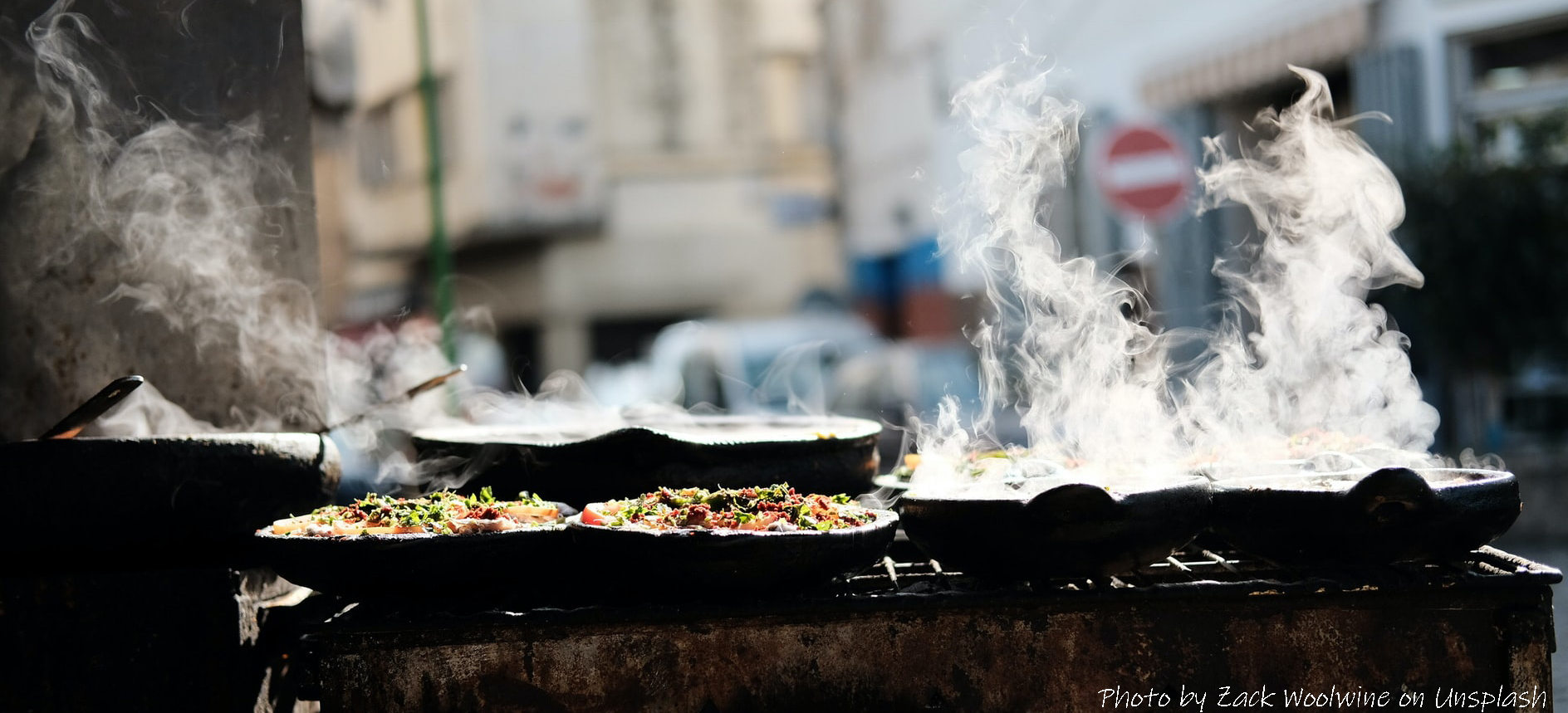
Recipes make wonderful souvenirs for people who like to travel light. Souvenir recipes weigh nothing, usually cost nothing and you can collect loads of them without any of them ending up as dust gatherers in forgotten cupboards.
The word souvenir itself is a straight grab from the French souvenir, meaning memory. And nothing stimulates memory as powerfully as taste and smell. Prepare a treasured recipe collected during a foreign vacation, then close your eyes and you can imagine yourself back on a beach in Greece, in a Turkish market, a caffè in Milan or beside a steaming vent in the earth near an Icelandic volcano.
Travel writers and bloggers – experts at travelling light – are inveterate collectors of recipes and foodie experiences. So recently, after struggling to recreate an unusually seasoned dish from Greece (see below), I polled several of them about the recipes and cookery tricks they’d collected on their travels. After my own boozy Greek meatball recipe, see what those seasoned travellers shared with me.
And if you do try any of the recipes that follow, please do let us know about it in the comments below.
First – Going Greek with a twist
The scent of ouzo, Greece’s anise flavoured – and lethally more-ish aperitif – did it for me recently, taking me back to an open-air kitchen in Santorini. Chef Miltos, of the luxurious Andronis Concept Wellness Resort, gave me a cookery lesson in a portable kitchen, shaded by a canopy from the searing hot sun. Somehow, between the island and home, I mislaid my notes about some of his recipes. But the memory of meatballs, seasoned with ouzo, oregano and mint, lingered. They were tiny and very tender, fragrant with the familiar wild herbs used in Greek cooking. The flavour and scent of the ouzo created an unmistakable yet subtle background note.
These would be great as part of a mixed meze of small dishes. Or make them slightly larger and stuff them into warm pita bread with Greek salad. I first ate them served with toothpicks, as hors d’oeuvres, without extra sauces. That way the hint of ouzo shines through and that’s the way I like them best.
Santorini Keftedes
After a bit of trial and error, I succeeded in creating a close approximation of the originals. Start this recipe the day before – or at least several hours ahead of time – so the flavours can blend. Try them alongside ntomatokeftedes, another Santorini speciality.
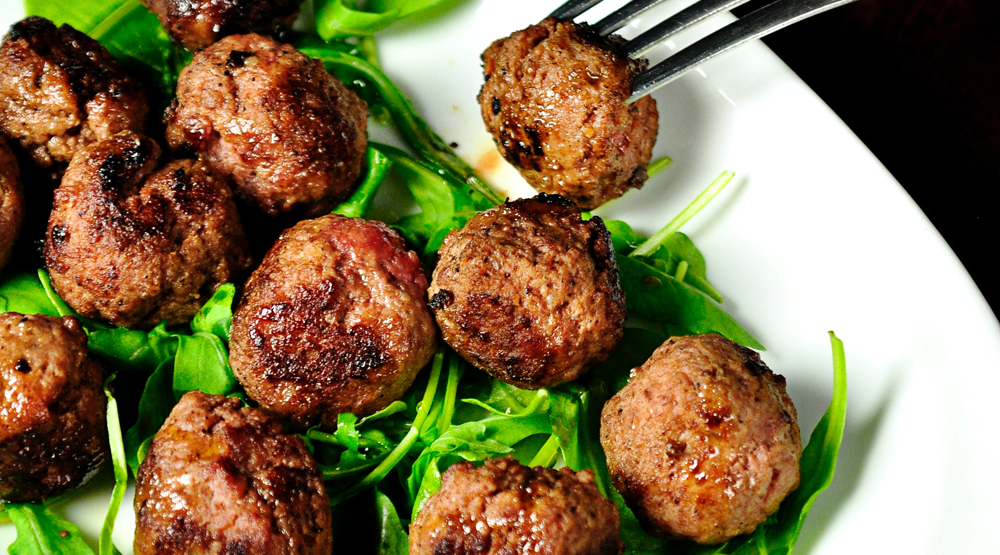
Beef, pork, mint, wild oregano and a touch of ouzo make these Greek meatballs very special. Photo by Emiliano Vittoriosi on Unsplash
Ingredients
- 1 lb lean ground beef
- 1/2 lb ground pork
- 1 small yellow onion grated or very finely chopped
- 1/2 tsp dried mint plus several tablespoons fresh mint, shredded
- 1 tsp dried oregano
- a good dusting of freshly grated nutmeg – about 1/2 tsp
- 4 or 5 slices of stale white bread, soaked in milk or water
- 2 tbsp good quality virgin olive oil
- 1 large egg, beaten
- 1 or 2 shots of *ouzo
- salt and pepper to taste
- plain flour
- vegetable oil – preferably sunflower or rapeseed (canola)oil – for frying
*About the ouzo – This ingredient is essential to the flavour of the dish, but the alcohol evaporates completely in the cooking, so no worries for teetotallers.
Preparation
- In a large bowl, mix the meats, onion, dried herbs and nutmeg. Set the fresh mint aside for later
- Squeeze as much liquid as possible out of the soaked bread and add to the meat mixture
- Beat the egg with the olive oil and add to the mixture
- Splash in the ouzo and knead together with your hands until well blended
- Refrigerate in a covered bowl overnight or at least six to eight hours
To cook
- Heat a small amount of oil in a pan and fry a teaspoon of the mixture, check the seasoning and then season the rest with salt and pepper to taste
- Dust a dinner plate with a generous amount of plain flour
- Form the remaining mixture into small meatballs, roll in the flour and then set aside on a baking sheet or large platter. The mixture should make 20 to 25 meatballs
- Heat the vegetable oil to 180C/ 350F in a large deep frying pan. The amount of oil will depend on your pan but try to cover it with about half an inch of oil. To check the temperature of the oil, drop in a cube of stale bread. It should take about 60 seconds to brown to a deep, toasty colour.
- Fry the meatballs in small batches until they are brown and crusty. Remove with a slotted spoon and drain on paper towels.
- Sprinkle with the shredded mint and serve.
More world cuisine “souvenir” recipes:
Explore all the recipes
Prawns “Amigo” – a recipe souvenir from the Algarve
Kacie Morgan is an award-winning blogger who writes about food and travel at The Rare Welsh Bit. She reports that the best dish she tried, during a trip to Lagos in the Portuguese Algarve, was at an unassuming snack bar – the O Amigo Snack Bar – near her hostel. She was so taken with their special prawns, she couldn’t wait to recreate it when she returned home. She writes:
Prawns “Amigo” consisted of jumbo king prawns cooked with extra virgin olive oil, garlic, chilli, white wine, parsley and brandy. From the very first taste of that oily broth, the flavour just completely blew me away. It was almost addictive; if I lived in Lagos, I wouldn’t be able to stay away from this place. This dish was served in a clay earthenware dish and accompanied by a side of freshly boiled rice to mix in with the prawns, and a vibrant side salad.
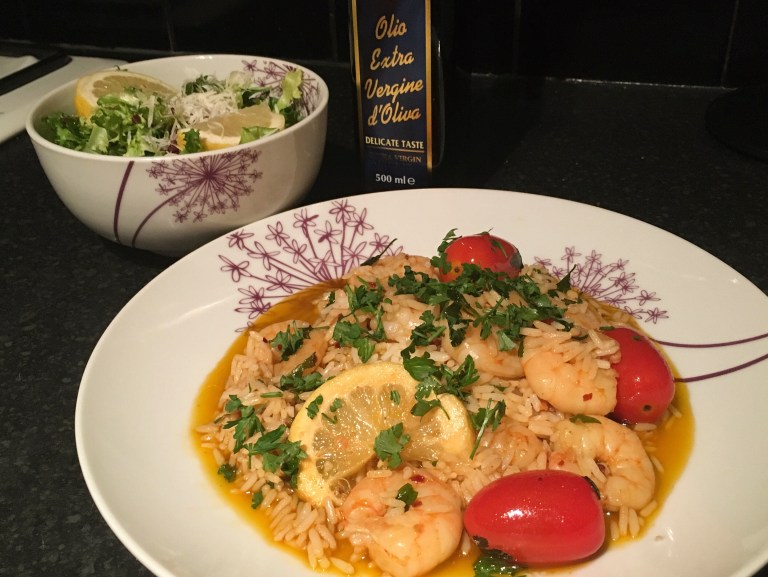
Prawns “Amigo”, a dish of prawns with garlic, olive oil, chilli and more. Photo by Kacie Morgan.
I couldn’t stop thinking about this dish after I got home, so I decided to have a go at making it myself. I had a look around for similar recipes online but I didn’t find anything quite like what I’d tried in Portugal, so I came up with my own recipe based on the ingredients the restaurant told me they’d used.
Read more about Kacie’s Portuguese experience and the recipe for Prawns “Amigo” it inspired.
When in Rome…Spaghetti carbonara with Parma ham
Stuart Forster, creator of the blog Go · Eat · Do, is a professional traveller, writer, photographer and gourmand. He remembers first tasting spaghetti carbonara in Rome, many years ago and as he describes it, it had little resemblance to the creamy concoction usually served outside of Italy.
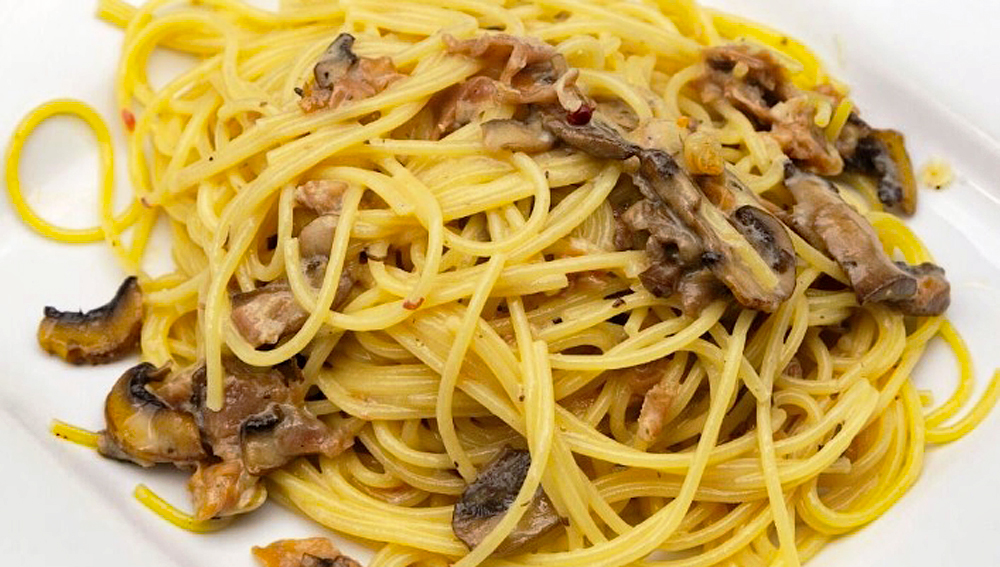 Real spaghetti carbonara as the Romans eat it is never floating in cream. Stuart Forster’s recreation of the dish includes some of his own special touches. Photo by Stuart Forster.
Real spaghetti carbonara as the Romans eat it is never floating in cream. Stuart Forster’s recreation of the dish includes some of his own special touches. Photo by Stuart Forster.
Since that first taste it’s remained one of his favourite Italian dishes. He writes:
I was a teenager on an Interrail tour around Europe. Despite money being tight, I was determined to taste as many local dishes as possible on my rail journey around the continent.
After a day exploring the Vatican, he chose a trattoria not far away. His choice of dinner that night had more to do with his knowledge of Italian history than with his knowledge of Italian food at the time.
To be honest, spaghetti carbonara wasn’t a dish that I knew. However, the name jumped out because I enjoyed reading about the unification of Italy and the history of the Risorgimento movement. The Carbonari were secret societies that pushed for change in the early part of the nineteenth century. Their name translates literally as ‘the charcoalmakers’.
Back in London, Stuart looked for a recipe to recreate the dish he’d eaten in Rome. But most involved lashings of cream. What he remembered was a sauce that included nothing more than beaten egg yolks, freshly ground black pepper, grated pecorino cheese and chunks of guanciale – cured pig cheeks.
Eventually, he created his own tasty version with the addition of Parma ham (prosciutto), mushrooms and whole eggs.
Read his recipe for Spaghetti carbonara with Parma ham along with fascinating insights into the making of the popular salted and air-dried ham.
Balinese Sambal Matah – When the sauce is the star
Larch Gauld is The Silver Nomad. She writes about travel and food from an over-50s perspective and
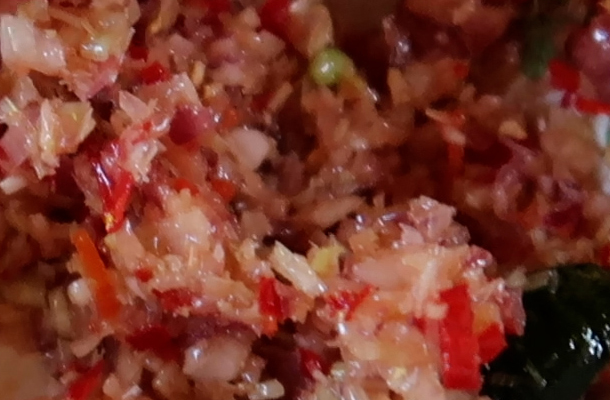
Spicy and fresh Sambal Matah. Photo by Larch Gauld
describes herself as “a real woman with cellulite.” That doesn’t stop her from travelling to adventurous destinations in Africa, Asia, Central and South America and the Middle East. Along the way, she collects souvenir recipes and says, “Sometimes the hero of a meal is not the main dish, but the accompaniments, those little additions that heighten the taste buds and add that tantalising extra zing to what you are eating.”
This Balinese cross between a raw salad and a relish is a case in point. She writes:
For me, when I visit Bali, the standout accompaniment is Sambal Matah. The raw sauce is a blend of lemongrass, shallots, chillies, coconut oil with the sharpness of lime juice and tang of shrimp paste adds a lemon bite to chicken, fish or vegetable dishes. Mouthfuls are sweet, sour, hot, cooling and lemony all in one.
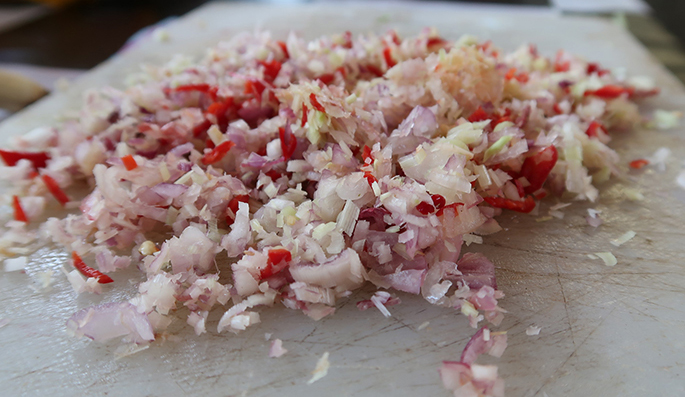 She says the recipe can be made in five to ten minutes, depending upon your chopping skills. As you can see below, there’s plenty of chopping involved. I was particularly interested in the way she toasts shrimp paste before using it – a little trick I plan to try
She says the recipe can be made in five to ten minutes, depending upon your chopping skills. As you can see below, there’s plenty of chopping involved. I was particularly interested in the way she toasts shrimp paste before using it – a little trick I plan to try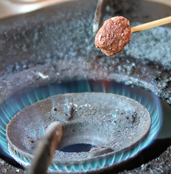 soon. See Larch’s step by step instructions here, plus tips about the role of sambals in Indonesian meals and where to obtain some of the special ingredients.
soon. See Larch’s step by step instructions here, plus tips about the role of sambals in Indonesian meals and where to obtain some of the special ingredients.
Homemade Lahmacun – Turkish spiced lamb flatbreads
A while back, I tried a meaty, spicy flatbread in the cafe at Strawberry Hill, the eccentric, faux medieval castle in the London suburbs. I’d never tasted anything like it and haven’t seen it on any menus since. Then I spotted Kavita Favelle’s recipe on her unabashedly foodie blog, Kavey Eats.
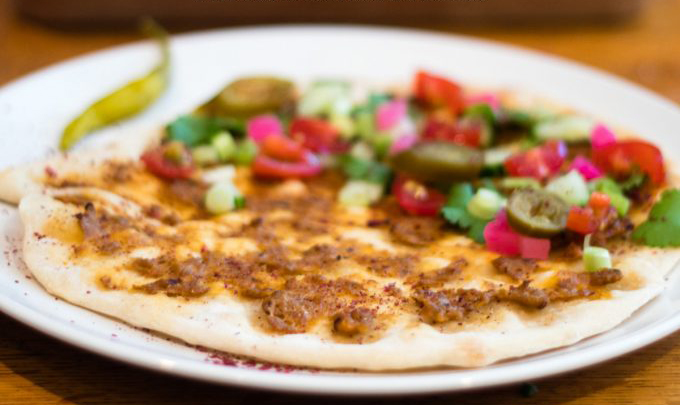
Lahmacun, Turkish lamb flatbread. Photo by Kavita Favelle
Kavey describes lahmacun as, “Circular flatbreads topped with a thin spread of spiced lamb and baked fast and hot until they are crisp, these delicious pizza-like treats originated in the Ottoman Empire, especially Armenia, Iraq, Lebanon, Syria and Turkey.”
She explains:
In Turkish restaurants lahmacun is usually served with a huge pile of fresh salad. I like to cut my lahmacun in half and fold it around a mix of salad ingredients, eating it with my hands.
It sounded like the flatbread I had tasted in Twickenham and had been looking for ever since. So I decided to have a go. As Kavey promised, the dough is really easy to make. Because we are in lockdown right now I couldn’t travel beyond my immediate neighbourhood to find minced lamb, so I had to settle for beef. It still worked and piling the salad on top was delicious.
As soon as I can find some lamb, I will make this again. In the meantime, here is Kavey’s recipe for you to try yourself. Highly recommended, three stars!
Piernik gingerbread cake – a Polish souvenir recipe
Karis, a writer at Ladies What Travel visited Poland last December as part of a foodie promotion. While there she visited Toruń where they have been making gingerbread since the 13th century. Inspired, she created this gingerbread cake. It’s light and layered – quite different from the dense, sticky version you might be used to around this time of year. Karis added a few of her own touches – a blueberry and rose petal filling instead of the usual plum jam, and a drizzle of white chocolate for a really sweet treat. She writes:
If you’ve read anything else I’ve written for Ladies What Travel, it will come as no surprise that I’m all over food with a history. Polish gingerbread certainly fits that criterion. As far back as the 13th Century, gingerbread has been made in Toruń and while it has changed somewhat over the years, it’s considered a national icon…This cake has a lovely spice and is very light. It would look great on an afternoon tea table and is a fancier alternative to gingerbread biscuits.
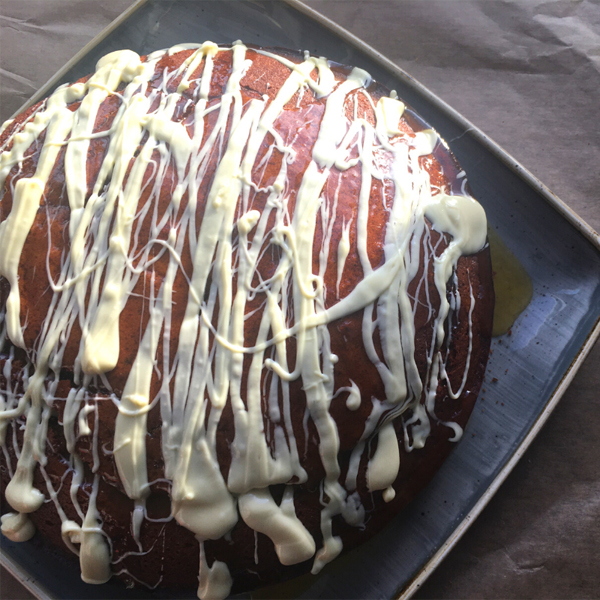
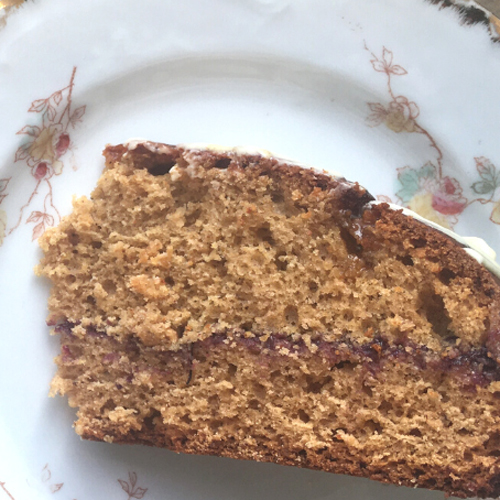
Click here to check out Karis’s recipe and try it yourself
Succulent and savoury Zuppa Gallurese – A Sardinian souvenir recipe
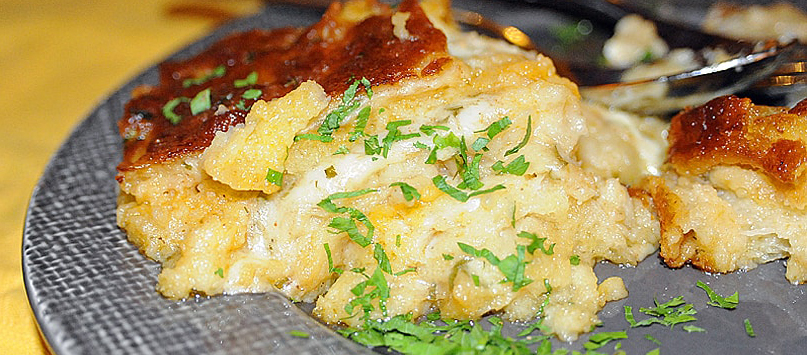
Photo by Kathryn Burrington
Thrifty cooks all over the world make delicious dishes out of leftover, stale bread. In England they make bread pudding, a sweet dessert. New Englanders layer stale buttered bread with grated cheddar cheese, soak it with beaten eggs and milk and produce a souffle-like speciality called strata. Tuscan cooks combine stale bread with juicy ripe tomatoes for the salad known as panzanella.
Award-winning photographer Kathryn Burrington travels the world with her camera and her appetite, bringing back gorgeous pictures and luscious recipes for her blog, Travel with Kat. She discovered this succulent, savoury bread pudding in Sardinia. With only a handful of ingredients – cheese, broth, bread and parsely – it’s a warming, economical and comforting dish. And it seems just right for this time of year. She says it’s a traditional peasant dish, believed to date back to the middle ages, adding:
I first tried Zuppa Gallurese during a traditional Sardinian feast at an agriturismo in the north-east of the island. This tasty and filling comfort food recipe is perfect for a chilly evening and it’s really easy to make.
Icelandic Thunder Bread
Suzanne Jones, The Travel Bunny, took a whirlwind 24-hour trip to Iceland where she learned about a traditional bread made underground in geothermal springs.
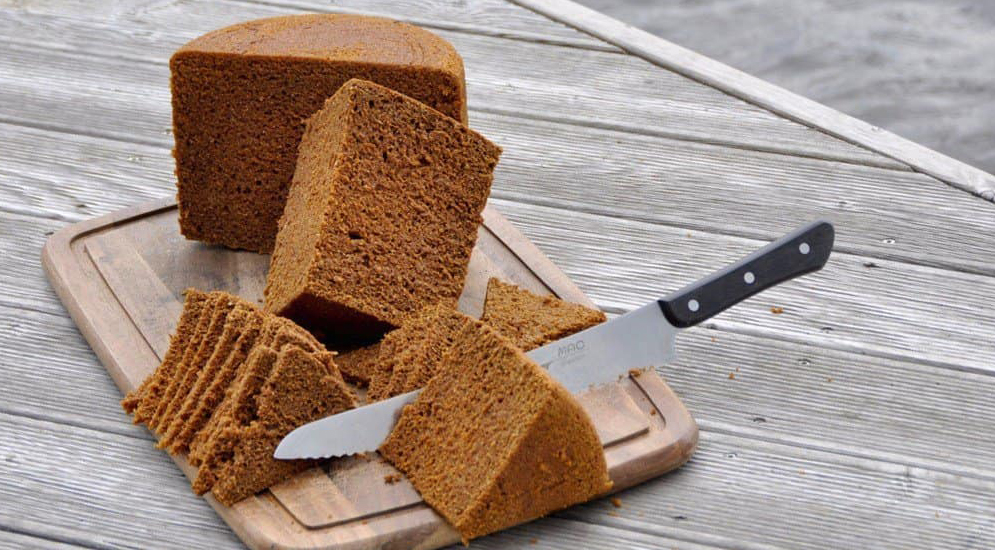
Icelandic Thunder Bread cooked in a geothermal spring
Thunder bread is just a nickname for this dense, sweet rye bread. It’s actually called Hverabrauð and is a traditional specialty with as many different versions as there are Icelandic cooks. Suzanne describes part of the five hours process of making it:
We went outside to the lakeside to watch Siggi (Icelandic chef Sigurdur Hilmarsson) bury the bread in the geothermal spring. We could see steaming bubbles exploding in the black volcanic sand by the water’s edge and smell the faint, eggy smell of sulphur in the air.
First, Siggi dug up the previous day’s thunder bread and cooled off the hot pot in the lake. Next, he buried the freshly made pots of thunder dough in the geothermal spring.

Rosie’s Deli Cafe owner and presenter Rosie Lovell watches Chef Sigurdur Hilmarsson bury the thunder bread in bubbling hot sand. Photo by The Travel Bunny
Don’t worry if you don’t happen to have a volcanic hot spring in your back garden. The bread can be made in a very slow oven, or even a slow cooker. How the bread earned the nickname thunder bread will give you a giggle. To find out about that, along with the recipe and more details of Suzanne’s Icelandic adventures click here.
And don’t forget – if you try any of these recipes, please let us know in the comments below. If you take a picture, we’d love to see that too.



 NYPL Digital Collection Public domain
NYPL Digital Collection Public domain Ferne Arfin 2020
Ferne Arfin 2020
This brings back memories, not just of the feast in Sardinia, but of cooking lessons on Santorini. I learnt all the dishes you mentioned. I’ll have to compare our recipes and make them again, although I can’t help but associate Santorini flavours with the summer. Silly really as these dishes must be scrumptious any time of year. Great post, Ferne. I must try Kavey’s flatbread too!
You’ve included some tasty recipes here. Rather than souvenirs, I find it lovely to return from a trip with a new recipe to cook.
These meals look amazing! I really like to cook different food and finding new things to try, especially at the moment when it’s an easier way to travel without leaving home. I’ve tried cooking carbonara this year for the first time from scratch but haven’t managed to get it quite right so far. This has given me new motivation to try again and maybe add a few more to the list.